Investigation of Ammonia-Hydrogen Mixture as a Green Fuel for Jet Engines Using a Wave Reformer
| Pejman Akbari1
California State Polytechnic University Pomona, CA, 91768, USA |
Colin D. Copeland2 Simon Fraser University Vancouver, BC, V3T 4B7, Canada | Stefan Tüchler3
New Wave Hydrogen Inc., Canada |
| Alison M. Ferris4 Stanford University, Stanford, CA 94305, USA | David F. Davidson5 Stanford University, Stanford, CA 94305, USA | Ronald K. Hanson6 Stanford University, Stanford, CA 94305, USA |
This paper explores the idea of thermally cracking ammonia via shock waves to produce a blend of ammonia-hydrogen as a ‘carbon neutral’ aviation fuel, reducing global carbon dioxide emissions. The method is based on wave rotor technology utilizing the energy contained in the combustor burned gas to compress and heat ammonia to temperatures at which high conversion rates can be achieved on short timescales. Then, the resulting ammonia-hydrogen mixture is fed into the burner as reactant which leads to hydrogen, nitrogen, and water vapor as primary gas products. The shock wave process has been modeled numerically using an in-house quasi-one-dimensional code by Tüchler and Copeland that has been experimentally validated for non-reacting wave rotors. A single-reaction, global kinetic model was developed to approximate the NH3 pyrolysis reaction chemistry across the temperature and pressure conditions of interest, thereby enabling the incorporation of chemistry in the numerical simulations. The computational results provide data used in the prediction of flow fields inside the channels of the wave reformer and at the inflow/outflow ports of the reactor. The data confirm production of a mixture of ammonia and hydrogen using energy harvested from the engine burner exhaust. This study introduces a new application of the shock-wave reforming process as well as another step in the realization of ammonia as an aviation fuel without carbon content.

